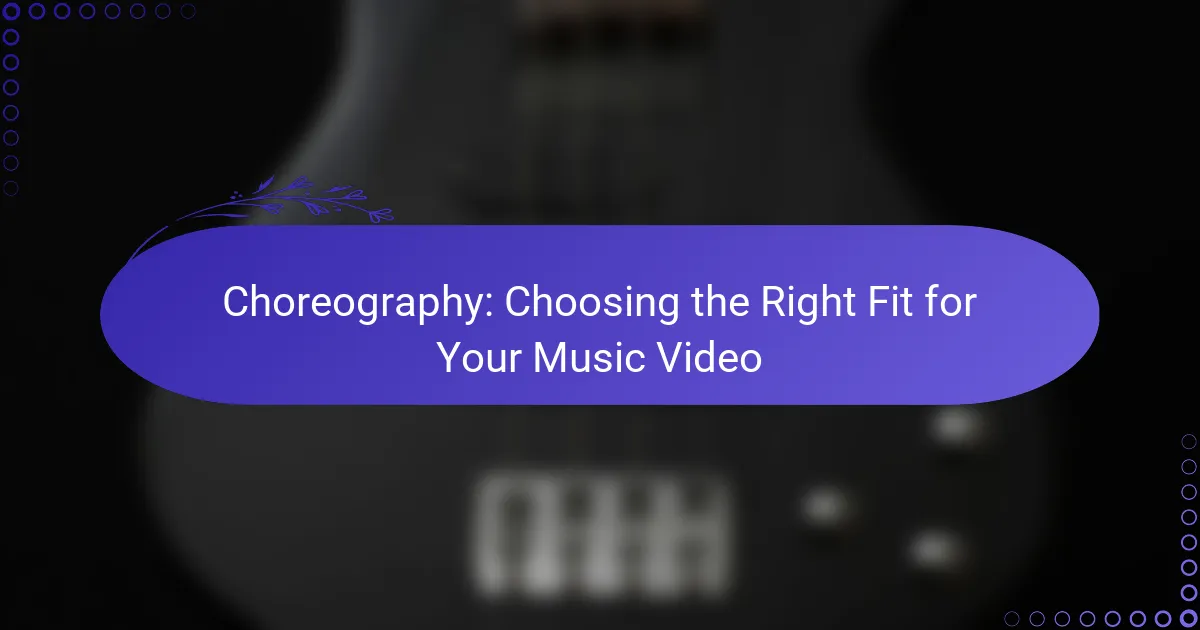Choosing the right choreography for your music video is essential for creating a compelling visual narrative that resonates with your audience. By aligning the dance style with the music genre and the song’s message, you can enhance viewer engagement and storytelling. Collaborating effectively with choreographers through clear communication and defined goals will ensure that the choreography complements your artistic vision.
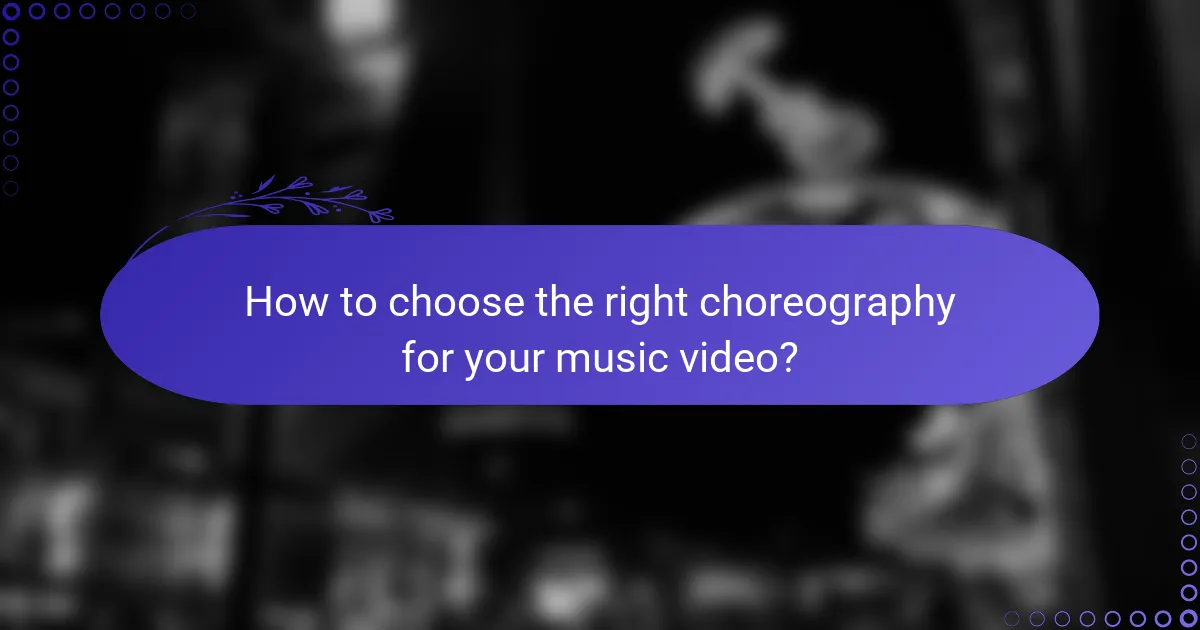
How to choose the right choreography for your music video?
Choosing the right choreography for your music video involves aligning the dance style with the music genre, audience expectations, and the song’s overall message. Effective choreography enhances the visual storytelling and engages viewers, making it crucial to consider these factors carefully.
Consider the music genre
The music genre significantly influences the type of choreography that will resonate with viewers. For example, hip-hop often features street dance styles, while pop may incorporate more polished, synchronized movements. Understanding the conventions of your genre can help you select choreography that feels authentic and appealing.
Additionally, consider the tempo and rhythm of the music. Faster beats may call for energetic, dynamic movements, while slower songs might benefit from more fluid, expressive choreography. This alignment ensures that the dance complements the musical elements effectively.
Assess the target audience
Your target audience plays a vital role in determining the choreography style. Different demographics may have varying preferences for dance styles, so it’s essential to understand who will be watching your video. For instance, younger audiences might gravitate towards trendy, viral dance moves, while older viewers may appreciate classic styles.
Engaging with your audience through social media or surveys can provide insights into their preferences. Tailoring the choreography to meet these expectations can enhance viewer connection and increase the likelihood of sharing the video.
Evaluate the song’s message
The choreography should reflect and enhance the song’s message or theme. If the lyrics convey a story of empowerment, the movements might be strong and assertive. Conversely, a romantic ballad could feature softer, more intimate choreography that evokes emotion.
Consider how the dance can visually interpret the lyrics or mood of the song. This alignment creates a cohesive experience for the viewer, making the video more impactful and memorable.
Review successful music video examples
Take note of specific elements such as formation changes, transitions, and the use of space. Create a checklist of techniques that resonate with you and consider how you can adapt these ideas to fit your unique style and message.

What are the popular choreography styles for music videos?
Popular choreography styles for music videos include hip-hop, contemporary dance, jazz funk, and ballet influences. Each style offers unique characteristics and can significantly impact the overall aesthetic and message of the video.
Hip-hop choreography
Hip-hop choreography is rooted in street dance and emphasizes rhythm, expression, and energy. It often features sharp movements, isolations, and a strong connection to the music’s beat. This style is ideal for music videos that aim to convey a sense of urban culture or youthful exuberance.
When incorporating hip-hop choreography, consider the target audience and the song’s vibe. Collaborating with experienced hip-hop dancers can enhance authenticity and creativity. Avoid overly complex routines that may distract from the music’s message.
Contemporary dance
Contemporary dance blends various styles, including ballet and modern dance, focusing on fluidity and emotional expression. It often tells a story or conveys deep feelings, making it suitable for music videos with a narrative or artistic theme.
To effectively use contemporary dance, select dancers who can interpret the song’s emotions and themes. Ensure the choreography complements the music’s dynamics. Avoid rigid movements that may clash with the fluid nature of contemporary dance.
Jazz funk
Jazz funk combines elements of jazz dance with hip-hop, characterized by its upbeat tempo and playful movements. This style is energetic and often incorporates theatrical elements, making it a great fit for pop and upbeat tracks.
When choosing jazz funk, focus on creating engaging and visually appealing choreography. Use a mix of sharp and smooth movements to keep the audience captivated. Avoid overly complicated sequences that may hinder the performance’s energy and flow.
Ballet influences
Ballet influences in choreography bring elegance and precision to music videos. This style emphasizes grace, form, and technique, often enhancing the visual appeal of the performance. Ballet can be particularly effective in genres that value artistry and sophistication.
Incorporating ballet elements requires skilled dancers who can execute intricate movements flawlessly. Consider using ballet to contrast with other styles for dramatic effect. Avoid neglecting the emotional connection; even technical performances should resonate with the audience.
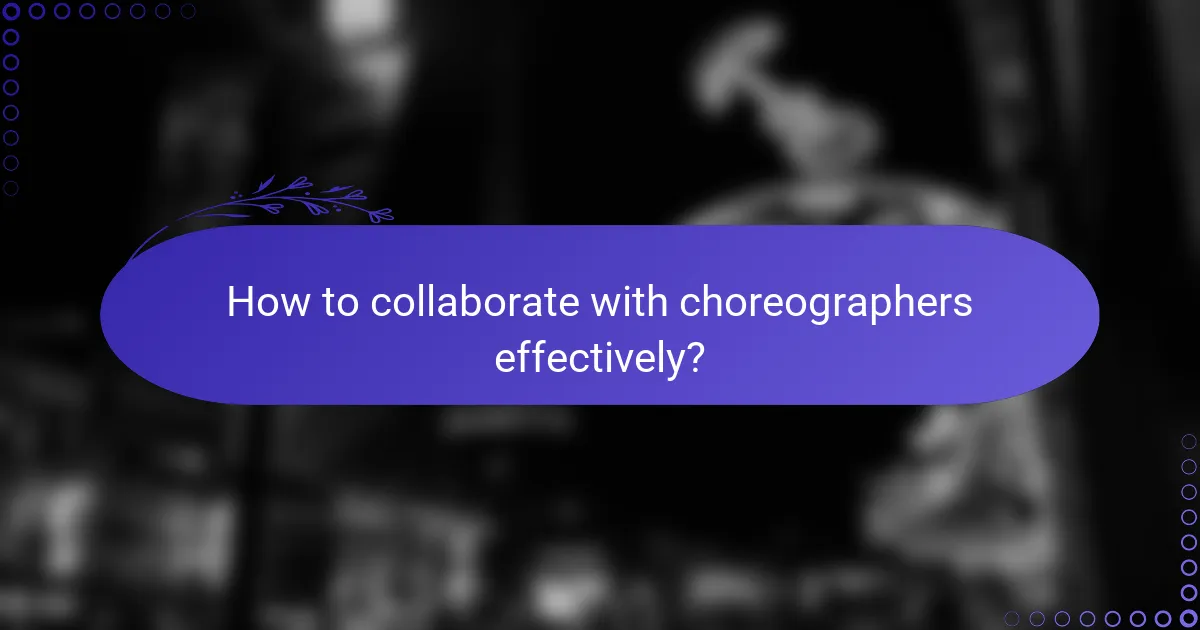
How to collaborate with choreographers effectively?
Effective collaboration with choreographers involves clear communication, defined goals, and ongoing feedback. Establishing these elements early in the process ensures that the choreography aligns with your music video’s vision and enhances the overall production.
Define clear objectives
Start by outlining the specific objectives for your music video. Consider what emotions you want to convey, the style of dance that fits your genre, and how the choreography will enhance the storytelling. This clarity will guide the choreographer in creating movements that resonate with your artistic intent.
For instance, if your video aims for a high-energy vibe, communicate that to encourage dynamic choreography. Conversely, if the focus is on intimacy, the choreographer can design movements that reflect that mood.
Communicate your vision
Sharing your vision with the choreographer is crucial for successful collaboration. Use visual references, such as mood boards or example videos, to illustrate the style and tone you envision. This will help the choreographer understand your expectations and create choreography that aligns with your artistic direction.
Regular discussions about your vision can also help refine ideas. Be open to suggestions from the choreographer, as their expertise may bring new dimensions to your concept.
Provide feedback during rehearsals
Feedback is essential during the rehearsal process to ensure the choreography meets your expectations. Attend rehearsals and offer constructive criticism, focusing on how well the movements align with your objectives. This ongoing dialogue helps the choreographer adjust the choreography as needed.
Consider using a feedback checklist to streamline your thoughts. Key points might include alignment with the music, emotional expression, and overall flow. Remember to balance critiques with positive reinforcement to maintain a collaborative atmosphere.
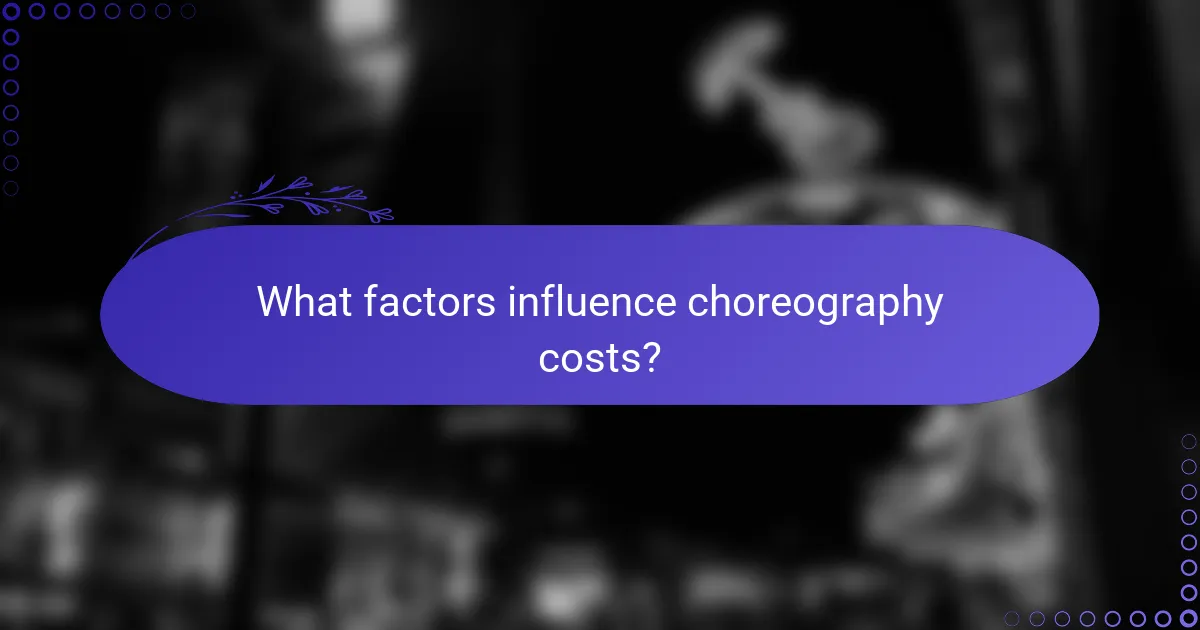
What factors influence choreography costs?
Choreography costs are influenced by several key factors, including the choreographer’s experience, the duration of the choreography, and the location and logistics involved in the production. Understanding these elements can help you budget effectively for your music video project.
Choreographer’s experience
The experience level of a choreographer significantly impacts their fees. Established choreographers with a strong portfolio and industry recognition typically charge higher rates compared to emerging talents. For example, hiring a renowned choreographer may cost several thousand dollars, while a less experienced one might charge a few hundred.
When selecting a choreographer, consider their past work and how it aligns with your vision. A well-experienced choreographer can bring creative insights and efficiency, potentially saving time and money in the long run.
Duration of the choreography
The length of the choreography directly affects the overall cost. Longer routines require more time for creation, rehearsal, and refinement, which can increase fees. A simple 30-second routine may cost less than a complex 3-minute performance.
When planning your choreography, aim for a balance between the desired length and the budget. Shorter, impactful routines can often be more effective than longer ones that may dilute the message or energy of the performance.
Location and logistics
The location where the choreography will be performed can influence costs due to travel, accommodation, and venue rental fees. If the shoot takes place in a major city, expect higher costs for these logistics compared to a smaller town. Additionally, consider any permits or insurance required for public performances.
To manage costs effectively, choose locations that minimize travel and logistical complexities. If possible, utilize local studios or spaces that offer reasonable rental rates to keep your budget in check.
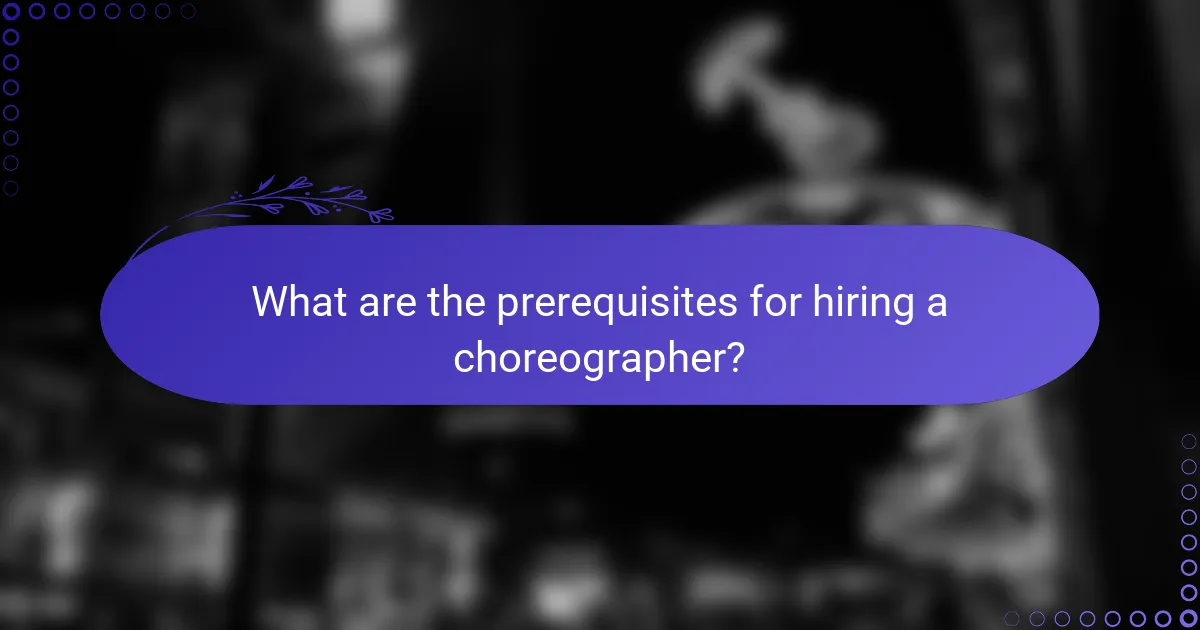
What are the prerequisites for hiring a choreographer?
Before hiring a choreographer, it’s essential to identify your project’s specific needs and budget. Understanding the style of dance required and the experience level of the choreographer can significantly impact the success of your music video.
Define your vision and style
Clearly articulating your vision and the desired style of choreography is crucial. Consider the genre of your music and how the dance will enhance the overall narrative. For example, hip-hop may require a different approach than contemporary dance.
Gather references from other music videos or performances that resonate with your vision. This will help communicate your expectations to potential choreographers, ensuring they understand your artistic direction.
Establish a budget
Setting a budget is a key prerequisite when hiring a choreographer. Rates can vary widely based on the choreographer’s experience, the complexity of the choreography, and the duration of the project. Typically, you might expect to pay anywhere from a few hundred to several thousand dollars.
Be upfront about your budget when discussing with choreographers. This transparency will help you find someone who can work within your financial constraints while still delivering quality work.
Consider the timeline
Having a clear timeline is essential for the successful hiring of a choreographer. Determine how much time you have before the shoot and how long you will need for rehearsals. A typical rehearsal period can range from a few days to several weeks, depending on the complexity of the choreography.
Communicate your timeline to potential choreographers to ensure they can accommodate your schedule. This will help avoid last-minute changes and ensure a smoother production process.
Assess the choreographer’s experience
Evaluating a choreographer’s experience is vital to ensure they can meet your project’s needs. Look for someone with a portfolio that aligns with your vision and style. Consider their previous work in music videos, live performances, or dance competitions.
Don’t hesitate to ask for references or testimonials from past clients. This will give you insight into their professionalism and ability to deliver results that match your expectations.
